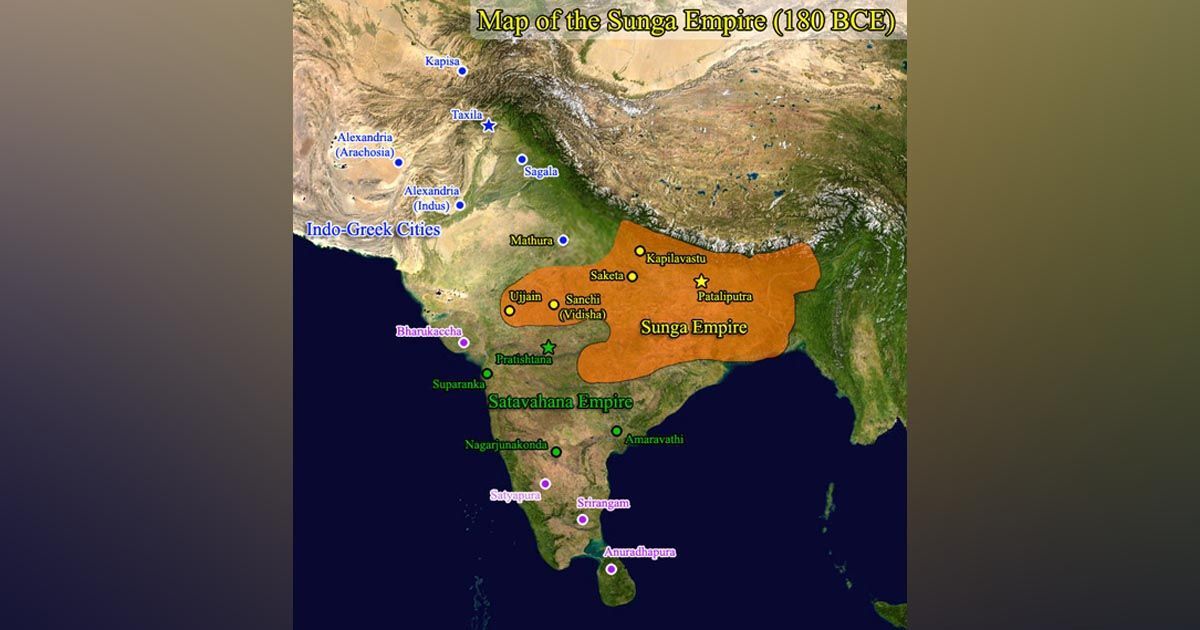
LakshyaforIAS, Guwahati.
lakshyaforia[email protected]
https://www.facebook.com/Lakshyaforias-233850620321465/
Part E7: POST-MAURYA INDIA
After the Maurya Empire's decline, it was not a very remarkable period for Indian political solidarity, but it saw development of Indian culture to a great extent. There were invasions from various foreign tribes, but Indian society continued its development by making alterations and additions in itself.
After the successors of Ashoka failed to keep the empire intact, various small kingdoms emerged in the Indian subcontinent. The Maurya Dynasty was soon replaced by the Sunga Dynasty.
SUNGA DYNASTY
The founder of the Sunga Dynasty was Pushyamitra Sunga (187-151 BC). He had assassinated the last Maurya ruler, Brihadratha to capture the throne.
The last ruler of the Sunga Dynasty was Devabhuti. He was murdered by his minister, Vasudeva Kanva.
KANVA DYNASTY
It was founded by Vasudeva Kanva. This dynasty was Brahmin by caste, and believed to be descendents of Rishi Kanva.
The last Kanva king was Susarman.
SATAVAHANA DYNASTY
After the decline of the Maurya Empire in the Deccan, the Satavahanas became politically prominent in the middle of the first century BC.
Gautamiputra Satakarni was the greatest of the Satavahana rulers. He extended the Satavahana rule by defeating the Shaka ruler Nahapana of Western India.
The kingdom extended from the Krishna River in the south to the Godavari in the north.
BACTRIAN INDO-GREEKS
After the death of Alexander in 323 BC, various Greeks settled on the north-western border of the Indian subcontinent.
The rulers of Bactria are called the Bactrian-Greeks, because they were Hellenistic (Greek) in their ancestry.
During the time of Pushyamitra Sunga, the invaders were ruled by Demetrius.
However, the most revered Indo-Greek ruler was Menander. His empire included southern Afghanisthan and Gandhara region (to the west of Indus).
SAKAS
The Sakas, also known as the Scythians, captured Bactria from the Greek rulers.
The most famous Saka ruler was Rudradaman I who ruled in the middle of the second century AD.
He is known to have undertaken the repairs of the Sudarshana Lake, which was originally built during the reign of Chandragupta Maurya. This has been mentioned on an inscription at Girnar/Junagarh in Gujarat.
PARTHIANS
The Parthians were Iranians in origin and had strong cultural connection with the Sakas. That is why both these groups are referred to as 'Saka-Pahlava'.
The 'Takht-i-Bahi' inscription at Mardan near Peshawar (dated 45 AD) refers to Gondophares as a Parthian ruler. He is believed to have taken up Christianity by association with St Thomas.
KUSHANAS
The Parthians were followed by the Kushanas, also known as Yuechis or Tocharians.
There were two successive dynasties in the Kushanas. The first dynasty was founded by Kadphises, who ruled for 28 years from 50 AD.
The second dynasty was founded by Kanishka, who is credited with convening the fourth Buddhist Council at Kundalavana, near Srinagar. This council had prepared an authoritative commentary on the Tripitakas and the Mahayana doctrine was given final shape here.
Kanishka is also known to patronise the Gandhara and Mathura schools of sculptural art. He had also sent missionaries to Central Asia and China to propagate the new faith of Buddhism.
He patronised the Buddhist scholars – Vasumitra, Ashvaghosha, and Nagarjuna. Kanishka also patronised the famous physician, Charaka.
POST-MAURYA DEVELOPMENTS
Internal and external trade:
The Dakshinapatha was the major internal land route which connected north and south India.
As regards to external trade routes, after the discovery of monsoons, more and more sea voyages were used for trading purposes.
Important ports of India on the western coast were Bharukachchha, Sopara, Kalyana, and Muziris. Prominent ports on the eastern coast of India were Tamralipti in West Bengal and Arikamedu on the Tamil Nadu Coast.
The best account of Indo-Roman trade is given in the book Periplus of the Erythrean Sea.
Indian exports included spices like pepper, perfumes, jewels, ivory, fine textiles like muslin, sandalwood, and steel.
Romans exported gold and silver to India. It is proved by the large number of Roman coins found in the subcontinent. This indicates an enormous drain of gold from the Roman empire towards India.
Indian crafts production:
Milindapanho mentions 75 types of occupations, of which 60 were solely associated with crafts.
The city of Ujjain was a prominent bead-making centre.
Mathura and Vanga were famous for their variety of cotton and silk textiles.
Trade and merchant guilds:
The communities of merchants that were organised in groups were known as 'shreni' or guilds, under the head known as 'shreshthi'.

